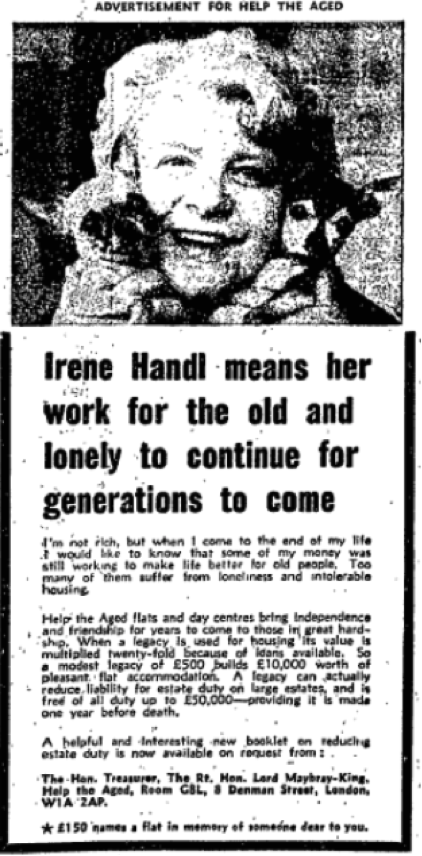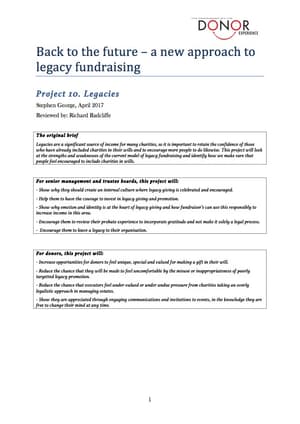CDE project 10 section 1: an overview of and background to legacy fundraising
- Written by
- The Commission on the Donor Experience
- Added
- April 30, 2017
The nature of true legacy
To leave a legacy is a natural human desire. Since the beginning of history, human beings have striven to pass on something of ourselves to future generations. We want to be remembered. We want to leave a mark, make a difference and help our families and loved ones do better. We are -wired to leave legacies.
This basic human emotion can be seen every day. From magnificent buildings spanning the centuries, to art, science, medicine, literature, history, even in street names, memorials and plagues, we see our quest to be remembered. But the truth is that, whilst this is a universal human feeling, for many, it manifests itself in more humble origins. Heirlooms, prized possessions and letters may be the sum of much of our worth – our assets and value. In a survey conducted by the UK Campaign Remember a Charity in 2015, over a quarter (28%) of the British public value the wisdom that loved ones have passed on more than they do money, keepsakes or property. There are many who see themselves as having nothing of worth to pass on to the next generation. Many make no provision. But the emotional drive remains, even if the practical action does not.
A background to legacy fundraising
So what exactly is legacy fundraising? Richard Radcliffe, probably the world’s most experienced Legacy Fundraiser, defined it in the following way:
‘A legacy is any gift (monetary or asset) left in a person’s will’.
It is, as Richard describes it, a gift. The mechanism for the gift is a will or the last testament of a person’s life, which is only received when they have passed on. As such, it conjures up the internal conversations we all have about our mortality, but it is unique as it costs us nothing in life. In fact, it is all about life and has the greatest resonance with who we are as human beings.
The use of a will as a means to take care of affairs, direct actions once someone has passed on to look after your family and friends is a universal tool. Cultures and countries may enact their own interpretations in law and process but, essentially, we can all use wills as a vehicle to manage our departure and last wishes. The act of giving through a will is ancient and equally universal. It goes back a long way. Redmond Mullin, in Foundations for Fundraising, describes an appeal for Troyes Cathedral that received approximately 4% of income from legacies between 1389 and 1423 (Foundations for Fundraising – Redmond Mullin 1995 ICAS Publishing). Legacies are a trusted and time-honoured way to give.
Over time, as wealth has grown and spread to the many and not just the few, the act of giving via a will has become more widespread. In the 18th and 19th centuries, some of the great institutions and organisations we use and take for granted today were started by gifts in wills. Many hospitals, churches, charities and societies were formed. As an example, Addenbrooke’s Hospital in Cambridge, one of the largest hospitals in Europe, was founded in 1766 with £4,500 from the will of Dr John Addenbrooke, a fellow of St Catharine's Colleges (https://en.wikipedia.org/wiki/Addenbrooke's_Hospital).
After the war, as the art and science of fundraising began to address the mass market, the process of fundraising for good causes developed new methods. Legacy Fundraising was no exception. In some parts of the world where the tax system encourages gifts, the route was planned giving by maximising tax advantages. For some, it remained a passive ‘wait and see’ exercise, almost like waiting for a lottery win or windfall. But for many, it transformed into a more deliberate action whereby charities reached out and encouraged, influenced and asked. In the 1970s and 80s, the advent of direct marketing by charities drove the development of mass marketing for legacies. However, to apply direct marketing to legacies meant addressing a fault line. Income from legacies was unpredictable and long term. How could a charity market an offer to an audience and not receive a return for a long time? To overcome this, charities created a direct-marketing approach to legacies. Firstly, an offer or enticement was made, often a will-writing pack or free guide. This recruited prospects. Secondly, the key metric became the revealing of the intent – what was to become called the pledge or pledgers. People who had told the charity that they had left a will.

This approach became the main driver of growth for legacy fundraising by charities. Therefore, methods and techniques began to develop based on this marketing approach. This allowed charities to become proactive, seeking and finding potential donors, and making offers to solicit a response with a much higher volume or reach. For others, the approach to legacy fundraising remained simply rooted in warm face-to-face visits, regular contact and relationship building. A small audience, usually known to the charity or organisation, meant a gentler and more personal approach could be followed. Some charities combined both approaches using a marketing engine that uncovered interest and a team of relationship ‘advisors’ who built relationships through advice and support. In the 1970s, Oxfam developed a network of volunteers to visit supporters at home to discuss legacies, soon to be replaced by paid staff. This model was repeated by a number of large charities. Today, there are many examples of teams of advisors supporting a charity’s legacy marketing.
Over time, however, there has been a change to this old model. Providing advice on writing wills to acquire new interest is less important as a tool to attract support, largely because the information is now widely available and the value thereof has been lost. Charities still provide information as a mainstay, but the means to engage and uncover support has become more cause-led. In the second pillar of the model, the concept of pledges has been broadened to embrace enquiries (this is discussed further in A donor-led viewpoint).
As we look back, it is worth quoting the words of the famous George Smith who, in Asking Properly, said of legacies:
Just about the third of all income to British charities comes in the form of legacies. Yet we plod around the opportunity is if we undertakers ourselves, clad in black crêpe bands hanging from a tall hats. We need not just admit the scale of the legacy programme to shout about its joy, its promise, its inherent customer satisfaction. For it is the only donation that never reflects in the donors current account. It is the only donation most of us will ever make in thousands, tens of thousands, hundreds of thousands of pounds. It is the only donation that just about everyone can make
We need to talk about legacies everywhere. We need stop apologizing to raising the issue. We need to stop coughing nervously.


















